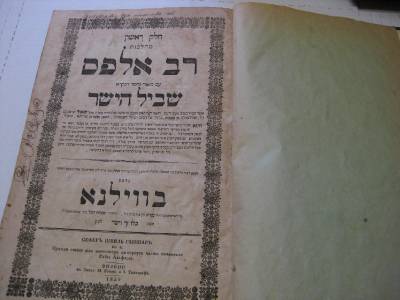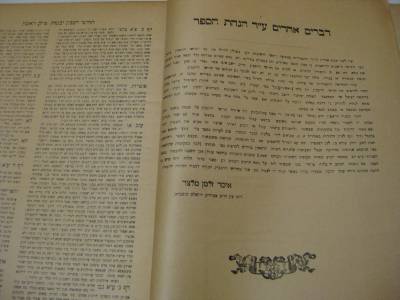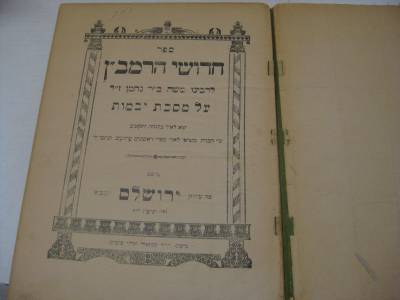In the last few weeks, a story of a Shanghai family looking for the owner of a Jewish Library that has been left by them in 1943, by a certain Carl Anger. The media of the world has been helping out in the search for this "Jewish Man" who has never returned to claim his library.
A careful look at the interview video with the safe keepers of the library shows that Mr Anger was a Christian!
Here is the letter of Mr Anger to the Shanghai family, as it appears in the interview.
A careful look at the words preceding the signature show "sincerely yours in Christ" !
Either the fellow was a Christian or a Jew who converted to Christianity, but searching for a Jewish owner to the books is bound to hit a dead-end.
You can read the entire article here and watch the video here. In the video, the letter appears at 2:20.
For those of you who haven't read about it yet, here is the story that has been going the rounds from cctv.
From 1933 to 1941, around 30,000 Jewish refugees fled the holocaust in Europe for Shanghai. One of the city’s refugee sections, in Hongkou District, will be pulled down within days, to make way for new residential apartments. A Shanghai family that has lived in the district for decades has been looking after over 2,000 books for a Jewish refugee for 70 years. Now the family is asking for help locating their owner.
The final days of a historical community. With the area soon to be demolished, residents have begun moving out. Pan Lu, who recently found a new home for the 2,000 books, brought us to the place where they were kept for 70 years.
"These books belonged to a Jewish man. He asked my father-in-law to look after them in 1943, and said that he would come back to collect them. My father-in-law waited many years for him to collect them." Said Pan Lu.
Lin Daozhi, the school principal who was entrusted the books, died in 1981. But the book owner never returned. It was no easy task fitting them all in, especially in a house less than 100 square meters. Over 10 family members have lived here, but none have ever thought of dumping the books to make more space.
"My son has been sharing the room with us, and slept on this soft bed until he was 16 years old." Pan said.
Looking after the books has become a tradition for the Lin family. They sealed them up in 1993 to better preserve them.
Sun Lide, Lin Daozhi's Grandson, said, "We put the books in order, then glued and nailed the wall to prevent rats and worms from damaging them."
And their efforts paid off. When the wall was opened after twenty years, most of the books were still in good shape.
"I worried a lot before opening the wall. But I was very relieved to see them in good condition." Sun said.
Demolition plans set the clock ticking to find the books’ owner. Just before moving out, Pan Lu found a letter Carl Anger sent from Germany to her late parents-in-law. "We arrived safely ... and we’re happy to be reunited with our relatives," the letter read.
"I never thought that I would find a postcard with the picture of Carl and his wife Paula." Said Pan.
Thanks to this new clue, the Lin family feel that they are getting closer to their goal.
"We hope that Carl and his family can contact us. The books belong to them, and when they get them back, our family’s mission will be complete.")
The Shanghai Jewish Refugees Museum has contacted the German Consulate-General in Shanghai to locate the Anger family. The Israeli Embassy has also offered its help.
Chen Jian, Director of Shanghai Jewish Refugees Museum, said, "Life was hard at the time, but the Chinese people helped the Jewish refugees as much as possible. And the two peoples built up close bonds and deep trust."
The books are being kept in a local library until their owner is found.
Hat-tip: Philip Steiglitz who with his great eye made the original discovery
Pages
▼
Tuesday, October 29, 2013
Monday, October 28, 2013
The testimony of the Pne Yehoshua on R. Zevi Hirsch of Gologory (d. 1766) author of אור צבי 1875
In 1875, in Lemberg, אור צבי by Rabbi Tzvi Hirsch of Gologory was printed for this first time. It received several Haskamot including one from Rabbi Joseph Saul Nathansohn. Nathansohn in his Haskamah notes an interesting story about the author, that the Pne Yehoshua, when he left Poland to Germany, stated that no one was left of his stature in Poland in חריפות other than the author of this work.
"ובאחד ההסכמות ראיתי כתוב לאמר כי הגאון בעל הפני יהושע עת נסעו מפולין למדינת אשכנז אמר שלא הניח איש גאון בחריפות כמו הגאון הלז"
Hat Tip: Rabbi Eliezer Katzman
"ובאחד ההסכמות ראיתי כתוב לאמר כי הגאון בעל הפני יהושע עת נסעו מפולין למדינת אשכנז אמר שלא הניח איש גאון בחריפות כמו הגאון הלז"
 |
| Nathansohn's Haskamah |
1929 ישראל יבין One author's opinion of Haskamot
In 1929 an anonymous author published a Sefer titled ישראל יבין in the city of Galante. The book contains a wide selection of Gematriot and similar "sciences".
In the place of Haskamot, the author writes that since nothing new is written in the book, he needs no Haskamot and concludes
כשם שקבלתי שכר על הדרישה כך אקבל שכר על הפרישה מן ההסכמות
"Just as I received reward for the studying so shall I receive reward for refraining from requesting Haskamot"
In the place of Haskamot, the author writes that since nothing new is written in the book, he needs no Haskamot and concludes
כשם שקבלתי שכר על הדרישה כך אקבל שכר על הפרישה מן ההסכמות
"Just as I received reward for the studying so shall I receive reward for refraining from requesting Haskamot"
Censorship of Encyclopedia Talmudit Vol I upon the request of Rabbi Isser Zalman Meltzer
In the first Volume of Encyclopedia Talmudit, in the articles titled אברים ב דף נד: there appears a discussion regarding the scientific validity of the Torah concept of 248 אברים in the human body. Quoted as one of the opinions, is that of Dr Katzanelson in התלמוד וחכמת הרפואה which concludes with the phrase ובאחדים מהאברים דרך אחרת לו קצת ממפרשי המשנה.
Rav Isser Zalman Meltzer found this paragraph inappropriate and sent a letter to Rabbi Meir Bar-Illan requesting that it be removed. All subsequent editions have this section removed, and the footnotes rearranged to eliminate a trail. The letter of Rav Meltzer appears in his correspondence which was published by his grandson.
Hat Tip: Menachem Silber
Rav Isser Zalman Meltzer found this paragraph inappropriate and sent a letter to Rabbi Meir Bar-Illan requesting that it be removed. All subsequent editions have this section removed, and the footnotes rearranged to eliminate a trail. The letter of Rav Meltzer appears in his correspondence which was published by his grandson.
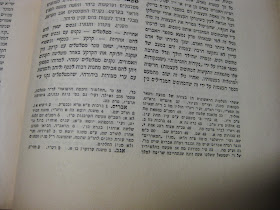 |
| NOTE 53 INCLUDES THE CENSORED TEXT |
 |
| THE CENSORED EDITION, NOTE THE REARRANGED FOOTNOTES |
 |
| THE CENSORED EDITION, NOTE THE REARRANGED FOOTNOTES |
Hat Tip: Menachem Silber
Thursday, October 24, 2013
Rabbi Shlomo Zalman of Volozhin and Rabbi Isser Zalman Meltzer, as book editors
There was a time when it was not beneath even the greatest of Jewry's leader's to edit and publish important Rabbinic works from manuscripts. One example is Shevil Hayashar by R. Saul Siskus (d. 1797) a commentary on the Alfasi, which was edited, with correction and notes by Rabbi Shlomo Zalman of Volozhin, known as Rabbi Zalmele, brother of Rav Chaim of Volozhin. R. Zalmele was just 21 years old at the time. Here is what the author, R. Srikus writes of R. Zalmele in the introduction to the work:
הקרה ה' לפני מקרה טהור גברא קטן בשנים א"ך גדול בענקים ינוקא קדישא חסידא ופרישא מילא אותו רוח אלוהים בחכמה ובתבונה ובדעת בכל הש"ס עם כל השיטות הפוסקים קדמאי ובתראי ערוכים ומחודדים בפיו לאמר בלי גמגום הוא ניהו קדושת שמו מפארים מור"ר שלמה זלמן........
In 1927, Rabbi Isser Zalman Meltzer, published and edited from various manuscripts, the Ramban's commentary to Tractate Yevamot, with a page-long scholarly introduction and notes throughout. Here are the photos of the original edition as published by Rabbi Meltzer
הקרה ה' לפני מקרה טהור גברא קטן בשנים א"ך גדול בענקים ינוקא קדישא חסידא ופרישא מילא אותו רוח אלוהים בחכמה ובתבונה ובדעת בכל הש"ס עם כל השיטות הפוסקים קדמאי ובתראי ערוכים ומחודדים בפיו לאמר בלי גמגום הוא ניהו קדושת שמו מפארים מור"ר שלמה זלמן........
 |
| The Haskamah for Shevil Hayshar by Rabbi Aryeh Leib Broide. Note how we praises the editor, Rabbi Shlomo Zalman more than the actual author |
 |
| From the Introduction to the book by the author, praising the encyclopedic knowledge of R. Shlomo Zalman |
 |
| Endless praise for Rabbi Shlomo Zalman in the sefer סערת אליהו Warsaw 1887 Edition. |
In 1927, Rabbi Isser Zalman Meltzer, published and edited from various manuscripts, the Ramban's commentary to Tractate Yevamot, with a page-long scholarly introduction and notes throughout. Here are the photos of the original edition as published by Rabbi Meltzer
The Halachic Side of The Baba Sali, Rabbi Israel Abuhatzeira A MANUSCRIPT IN HIS HANDWRITING
The Baba Sali, Rabbi Israel Abuhatzeira is famous for his being a kabbalist and his ability to perform miracles through prayers. What's less known about him, is that his early life was spent being the Rabbi of the Jewish Community in Arfoud, and Boudnib, as well as being the head of the Bet Din.
Someone brought in recently a large manuscript of over 100 pages, to evaluate for insurance purposes. The Manuscript is a ledger from the Bet Din where the Baba Sali presided, in his early years, while still in Morocco. The cases described in this ledger are mostly divorces that they processed, and each case is described meticulously in the manuscript, written by the court's scribe. At the end of each case, is a signature of each of the 3 members of the Bet Din including the Baba Sali, who headed it at the time. The cases are all dated in the 1930s, the Baba Sali was still in his early thirties then! A great reminder from the days when becoming a Kabbalist was preceded by having an encyclopedic knowledge of all sections of the Torah.
Below are some sample photos from the discussed manuscript
Someone brought in recently a large manuscript of over 100 pages, to evaluate for insurance purposes. The Manuscript is a ledger from the Bet Din where the Baba Sali presided, in his early years, while still in Morocco. The cases described in this ledger are mostly divorces that they processed, and each case is described meticulously in the manuscript, written by the court's scribe. At the end of each case, is a signature of each of the 3 members of the Bet Din including the Baba Sali, who headed it at the time. The cases are all dated in the 1930s, the Baba Sali was still in his early thirties then! A great reminder from the days when becoming a Kabbalist was preceded by having an encyclopedic knowledge of all sections of the Torah.
Below are some sample photos from the discussed manuscript
Sunday, October 20, 2013
Hasidut to the extreme - Sayings of Rabbi Uri ('ha-Saraf') mi-Strelisk אמרי קדוש published in Szekelyhid c1940
Some time before the war (no date appears in the book), a Sefer titled Imre Kadosh was published in Szekelyhid, Romania, one of the very few Hebrew titles published there. This edition does not appear in Bet Eked Sefarim. It contains sayings heard from the Saraf, Uri ben Pinḥas of Strelisk (1757–1826), one of the earliest Hasidic Rebbes, a talmid of Reb Shlomo of Karlin. It is a brief book, a total of 20 pages in length.
Within, is a treasure trove of brief sayings, many of the nature that caused the Mitnagdim to become suspicious of the movement.
Here are a few examples.
טוב יותר לאדם שיפיל עצמו לכבשן בוער באש מלהיות רבי וצדיק מפורסם
"It is better to throw yourself in to a burning fire than become a famous Rebbe or Tzadik"
שיש ליסע לצדיק אמת אפילו אלפיים פרסאות ולבטל בהליכתו ובחזירתו תורה ותפלה והכל רק כדי דבור אחד של אמת אשר אשמע מפי צדיק אמת
"You are obligated to travel to a true Tzadik even 2000 Parsaot, and suspend throughout the way there and back learning Torah and Prayer, all so he can hear just one word of truth from a true Tzadik:"
הזהיר להיות על שולחנו אורח בכל סעודתו אז אפילו אוכל כל שובעו כגוי גמור מ"מ נחשב כאילו כיוון כל כוונת האריז"ל ובתנאי שלא יאכל עם אשתו ובנותיו על שולחנו
"One who is careful to always have a guest present at his meals, even if he eats to his full appetite, like a total gentile, even so, it is considered as if he meditated all the Kavanot of the Arizal, all on the condition, that his wife and children do not eat together with him on his table"
Interestingly, this book was republished in 1961, with additions titled אמרי קדוש השלם. The above quotes have mysteriously disappeared from the later edition.
Here is a photo of the title of the 1961 edition.
Within, is a treasure trove of brief sayings, many of the nature that caused the Mitnagdim to become suspicious of the movement.
Here are a few examples.
טוב יותר לאדם שיפיל עצמו לכבשן בוער באש מלהיות רבי וצדיק מפורסם
"It is better to throw yourself in to a burning fire than become a famous Rebbe or Tzadik"
שיש ליסע לצדיק אמת אפילו אלפיים פרסאות ולבטל בהליכתו ובחזירתו תורה ותפלה והכל רק כדי דבור אחד של אמת אשר אשמע מפי צדיק אמת
"You are obligated to travel to a true Tzadik even 2000 Parsaot, and suspend throughout the way there and back learning Torah and Prayer, all so he can hear just one word of truth from a true Tzadik:"
הזהיר להיות על שולחנו אורח בכל סעודתו אז אפילו אוכל כל שובעו כגוי גמור מ"מ נחשב כאילו כיוון כל כוונת האריז"ל ובתנאי שלא יאכל עם אשתו ובנותיו על שולחנו
"One who is careful to always have a guest present at his meals, even if he eats to his full appetite, like a total gentile, even so, it is considered as if he meditated all the Kavanot of the Arizal, all on the condition, that his wife and children do not eat together with him on his table"
Interestingly, this book was republished in 1961, with additions titled אמרי קדוש השלם. The above quotes have mysteriously disappeared from the later edition.
Here is a photo of the title of the 1961 edition.
 |
| 1961 Edition of אמרי קדוש השלם |
On the hopes of Rabbi Shaul Brach that Rav Abraham Isaac Kook Convert to Christianity
In 1960, R. Tzvi Hirsch Friedman (student of the Minchat Eleazar of Munkacz, d.1969) published a Polemic קול קורא לעזרה against the Israeli Rabbinate in relation to a divorce sought by the author's sister. In between the attacks on the Rabbinate were published several letters against Rav Abraham Isaac Kook.
Referred to as אותו האיש, the letters present some of the most vicious attacks against Rav Kook Imaginable. Here is the letter of Rabbi Shaul Brach (1865-1940) one of the most prominent Hungarian Anti-Zionists as it appears in the book.
After comparing him to Shabetai Sevi, he states ויש תקוה טובה שגם הוא יתנצר and there is great hope that he too will convert to Christianity once his Zionist fever will die down. This was written in response to Rav Kook's few lines written in his Iggerot (page 47) in defense of Christianity. Refusing to address him by name, he writes that of his name, "which is alluded to in ישעיהו פרק כח ח". The Pasuk reads
כִּי כָּל-שֻׁלְחָנוֹת, מָלְאוּ קִיא צֹאָה, בְּלִי, מָקוֹם
קיא ראשי תיבות אברהם יצחק קוק. The word קיא translates as vomit.
A letter by Rabbi Eliezer David Gruenwald, the Rabbi of Satmar appears in the pamphlet as well. From among his many honorary titles that he gives Rav Kook is מאנשי בליעל, חובר חברים ספרי מינים וספרי אפיקורסות .....
The Rogatchover Gaon's letter against Rav Kook appears preceding them as well. It has been suggested that the Anti-Zionist letters attributed to the Rogatchover have been forged.
Friday, October 18, 2013
The Original Architectural Map of the Bratislava Jewish Cemetery where the Chatam Sofer is Buried
As part of a large collection of Ktav Sofer family letters I recently acquired, came what appears to be the original Architectural map of the Old Bratislava Jewish Cemetery, made in preparation for the cemetery's destruction by the Anti-Semitic Jozef Tiso in 1943.
The Destruction of the cemetery in 1943, is one of the most telling incidents of the life of the Jews living in Bratislava moments before their deaths. In 1942-1943, the cemetery was confiscated by the Slovak State and its anti-Semitic clero-fascist leader catholic priest Jozef Tiso in 1943 to build a roadway and the cemetery was largely demolished. Most of the graves were exhumed and reburied at the Orthodox cemetery in a communal grave behind the beit tahara. Only the most precious section, where famous Bratislava rabbis were buried – 23 graves surrounding the Chatam Sofer’s tomb – was preserved on the original site. Negotiations with the regime enabled the community to preserve this section of the cemetery including the Chasam Sofer's grave, enclosed in concrete, below the surface of the new road. The regime complied either as a consequence of a large bribe (according to one story), foreign pressure (according to another story), or for fear of a curse if the graves were destroyed (according to yet another story). It is fascinating to me, that the Jewish Community in such critical times, did all in their ability to save what they could of the cemetery.
The Map in my possession, was printed in November 1943, moments before the cemetery was grazed over. Between September 1944 and the end of the year, German units deported approximately 12,600 Slovak Jews, most of them to Auschwitz, Theresienstadt, and other camps in Germany. German and Hlinka Guard units killed a few thousand Jews caught in hiding or fighting with the partisans in Slovakia.
Below is the text in Slovak which appears on the map:
"POLOHOPISNY PLAN CIASTKY STAREHO ZIDOVSKEHO CINTORINA NA PODHRADSKEJ CESTE V BRATISLAVE KTORA MA BYT PRENESENA NA NOVY CINTORIN"
which translates roughly as Topographic plans for the Old Bratislava Jewish Cemetery that will be transferred to the New cemetery.
This map allows us to determine the accurate position of each of the graves, including the Chatam Sofer's plot, it would be interesting to see how it corresponds to the tombstones position today in the cemetery. I could find no record of another such map in existence, though it can be often very hard to locate other copies of such things.
Order of Preference in building your Jewish Library: Rabbi Moshe Hagiz Style
The last of the 613 Mitzvot in the Torah, is that of writing a Sefer Torah. Many Poskim today, include purchasing printed books in this Biblical Commandment, making the purchasing of Sefarim, a religious obligation, no less than buying an Etrog etc.
Rabbi Moshe Hagiz, in his commentary Eleh Hamitzvot on the 613 Mitzvot, guides the reader on which books you are obligated to purchase, provided you have the ability. It is interesting to note his preferences, and the titles he chooses to describe each genre, providing a mirror to what his personal library must have looked like, and to what was popular at the time.
His List goes something like this; Torah with Perush Rashi, Mishnayot, Shulchan Aruch. Menorat Hamaor, Reshit Chochma, Ein Yaakov & Midrash Rabbah. "And those that are blessed with wealth" should also buy a Talmud, Rif, Rambam and Bet Yosef.
He then describes choice works in the vernacular, works which have been translated such as Sefer Hachinuch, Menorat Hamaor, Sha'ar Hayirah of Reshit Chocham and the works of Menasseh Ben Israel, the choicest one being Conciliador, Nomologia o Discursos Legales of Immanuel Aboab, and Parafrasis Comentada sobre el Pentateuco of Isaac Aboab da Fonseca. The list ends with Isaac Cardoso's; Las Excelencias y Calunias de los Hebreos.
In 1765 רבי גדליה טיקוס published תורת קטן a shortened version of Hagiz's Sefer Hamitzvot. His clarification of the commandment takes it to the extreme. In his description of the Mitzvah, he writes, how "today, there is an obligation to buy as many books as you can afford so you will have the ability to learn from them... and through this may we merit the coming of Mashiach in our times, Amen. "
No mention of the Biblical obligation to purchase books is complete without mention of the famous Haskamah to Otzar Hasefarim Ben Yaakov, given to the sefer by Rabbi Shlomo Hakohen, the famed Av Beis Din and Posek of Vilna. I have heard in the name of Eliezer Brodt, that every collector should have this Haskamah on his wall. " ובכל ספר וספר שיקנה יקיים בזה מצוות עשה דאורייתא"
Below is the Entire Haskamah, starting on the left column.
Rabbi Moshe Hagiz, in his commentary Eleh Hamitzvot on the 613 Mitzvot, guides the reader on which books you are obligated to purchase, provided you have the ability. It is interesting to note his preferences, and the titles he chooses to describe each genre, providing a mirror to what his personal library must have looked like, and to what was popular at the time.
His List goes something like this; Torah with Perush Rashi, Mishnayot, Shulchan Aruch. Menorat Hamaor, Reshit Chochma, Ein Yaakov & Midrash Rabbah. "And those that are blessed with wealth" should also buy a Talmud, Rif, Rambam and Bet Yosef.
He then describes choice works in the vernacular, works which have been translated such as Sefer Hachinuch, Menorat Hamaor, Sha'ar Hayirah of Reshit Chocham and the works of Menasseh Ben Israel, the choicest one being Conciliador, Nomologia o Discursos Legales of Immanuel Aboab, and Parafrasis Comentada sobre el Pentateuco of Isaac Aboab da Fonseca. The list ends with Isaac Cardoso's; Las Excelencias y Calunias de los Hebreos.
 |
| 1887 Warsaw Edition of Eleh Hamitzvot |
 |
| 1887 Warsaw Edition of Eleh Hamitzvot |
In 1765 רבי גדליה טיקוס published תורת קטן a shortened version of Hagiz's Sefer Hamitzvot. His clarification of the commandment takes it to the extreme. In his description of the Mitzvah, he writes, how "today, there is an obligation to buy as many books as you can afford so you will have the ability to learn from them... and through this may we merit the coming of Mashiach in our times, Amen. "
 |
| Text from Torat Katan 1765 |
No mention of the Biblical obligation to purchase books is complete without mention of the famous Haskamah to Otzar Hasefarim Ben Yaakov, given to the sefer by Rabbi Shlomo Hakohen, the famed Av Beis Din and Posek of Vilna. I have heard in the name of Eliezer Brodt, that every collector should have this Haskamah on his wall. " ובכל ספר וספר שיקנה יקיים בזה מצוות עשה דאורייתא"
Below is the Entire Haskamah, starting on the left column.
The Ultimate Segulah: Learning from Sefer Kedushat Hashem of Rabbi Joseph Shapotshnick
There have been over the centuries a handful of books, which have gotten themselves Segulot associated with them, sometimes by the author's blessings and at times by outside recommendation. The sefarim of the Maharal Zunz of Plotzk is one example, who is Said to have stated "I will be an intermediary with the Almighty in the world to come for anyone who tries to bring to publication the books that I have compiled". The Siddur Shelah is another famous example, of which the Bach said of in his Haskamah “For there is no doubt that this will spread among Israel, whoever will
pray in this Siddur will always be heard and his prayer never ignored”.
In 1918 a Sefer titled Kedushat Hashem by Rabbi Joseph Shapotshnick was published. This fascinating work, on the sanctity of the divine name, delivers the ultimate Segulah for anyone willing to believe. The author, who brought the book to the press himself, stated in bold letters on the title page
"ובטוח אני כי כל מי שיקרא את הספר הזה מדי יום ביומו יתחזקו בו כל....ויזכה לאכול הפירות הטובות וברכת הצלחה בעולם הזה והקרן של אמונה וידיעה יזכה לעולם הבא להתענג על רב טוב"
The Author apparently really believed in his book and it's merits.
The Author, Rabbi Joseph Shapotshnick was one of the most colorful figures in recent Jewish History. Self-titled the Chief Rabbi of London, he got himself in to numerous troubles, with intense fighting taking place between him and the established rabbinate in London. A book about his fascinating life, has been in the works for nearly a decade now by Rabbi Pinni Dunner, titled "The Life and Controversies of Joseph Shapotshnick". Last I heard, it was scheduled to be published in 2015.
In 1918 a Sefer titled Kedushat Hashem by Rabbi Joseph Shapotshnick was published. This fascinating work, on the sanctity of the divine name, delivers the ultimate Segulah for anyone willing to believe. The author, who brought the book to the press himself, stated in bold letters on the title page
"ובטוח אני כי כל מי שיקרא את הספר הזה מדי יום ביומו יתחזקו בו כל....ויזכה לאכול הפירות הטובות וברכת הצלחה בעולם הזה והקרן של אמונה וידיעה יזכה לעולם הבא להתענג על רב טוב"
The Author apparently really believed in his book and it's merits.
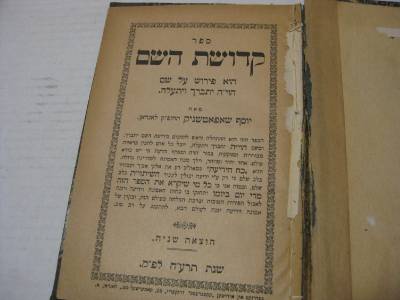 |
| title page of Kedushat Hashem by Rabbi Joseph Shapotshnick |
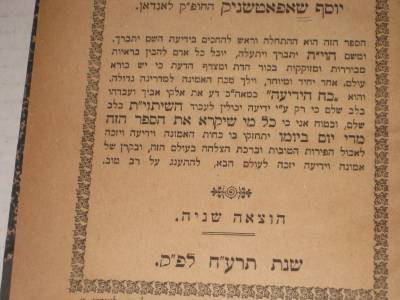 |
| Blessing appears in center of title page |
The Author, Rabbi Joseph Shapotshnick was one of the most colorful figures in recent Jewish History. Self-titled the Chief Rabbi of London, he got himself in to numerous troubles, with intense fighting taking place between him and the established rabbinate in London. A book about his fascinating life, has been in the works for nearly a decade now by Rabbi Pinni Dunner, titled "The Life and Controversies of Joseph Shapotshnick". Last I heard, it was scheduled to be published in 2015.









